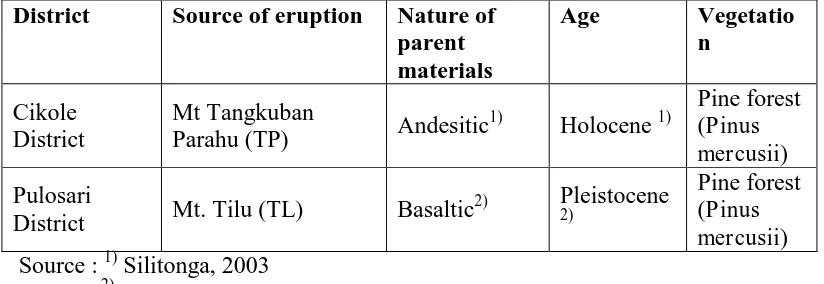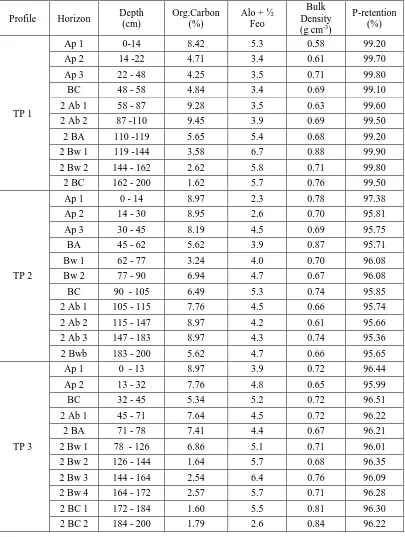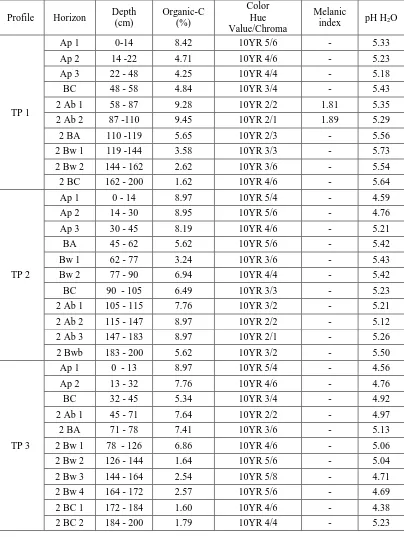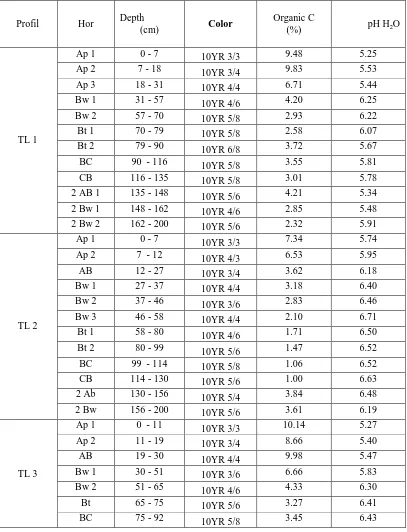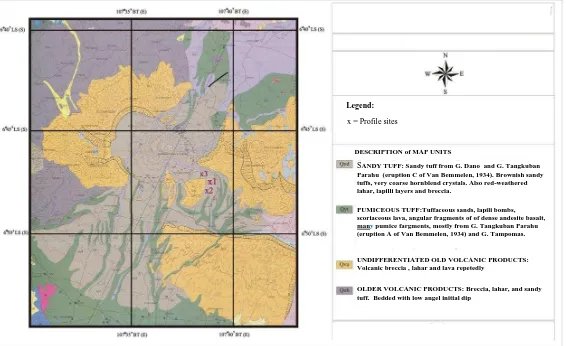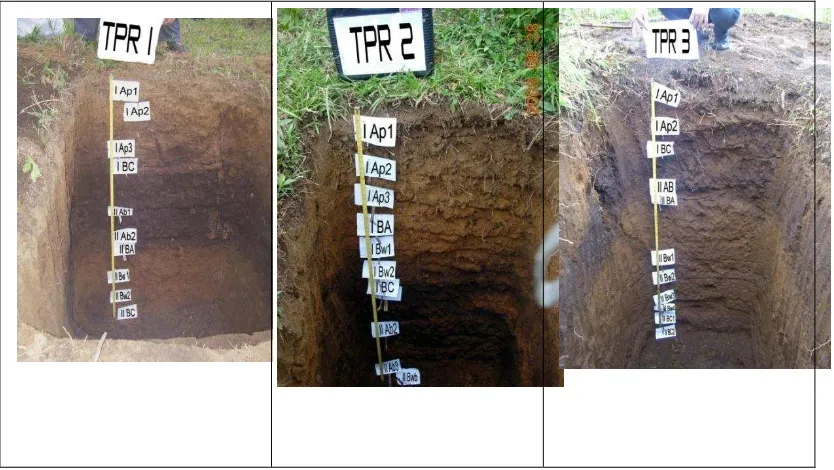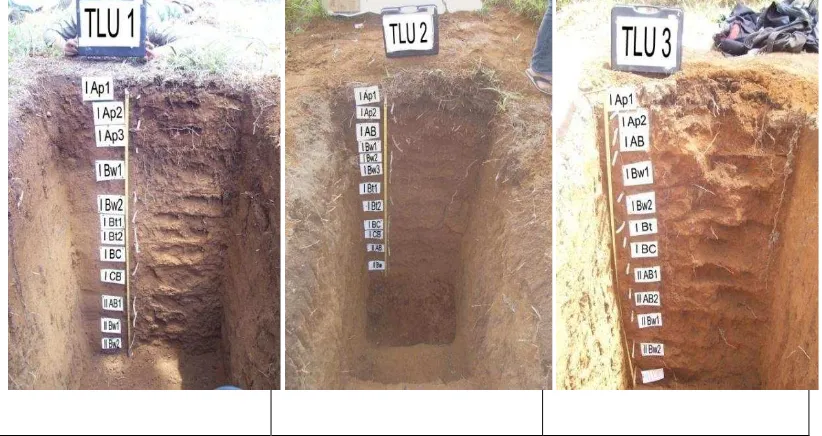1
INVESTIGATION OF MELANIC AND FULVIC ANDISOLS IN VOLCANIC SOILS
DERIVED FROM SOME VOLCANOES IN WEST JAVA
Rina Devnita
Department of Soil Science, Faculty of Agriculture, Padjadjaran University Jl. Raya Bandung-Sumedang km 21, Bandung 40600
Email: devnitarina@unpad.ac.id, rinabursi@yahoo.com
Abstract
Melanic and fulvic Andisols are the great groups in the classification of volcanic soils Andisols, which describe the soils with the high organic carbon content in the epipedon. The organic C must be more than 6% in the upper 30 cm with the value and chroma are 2 or less for melanic and more than 2 for fulvic. . Melanic epipedon also has to have the melanic index that is 1.70 or less. The objective of this study was to investigate the melanic and fulvic Andisols in the volcanic soils that developed under the pine forest vegetation from different parent materials and ages of Mt. Tangkuban Parahu (andesitic, Holocene) and Mt. Tilu (basaltic, Pleistocene). The method used was a descriptive comparative survey of three profiles in Mt. Tangkuban Parahu and three profiles in Mt. Tilu. Analyses were done for each horizon in the profiles comprise of the investigation of andic soil properties through the analyses of organic C, bulk density, Al + ½ Fe (ammonium oxalate) and P-retention. The investigations were continued by further calculation of organic C content and by investigation of soil color with Munsell Soil Color Chart. The results showed that the two profiles in Mt. Tangkuban Parahu and two profiles in Mt. Tilu are fulvic Andisol. No melanic Andisols found in both locations. Pine forest vegetation encourage the formation of fulvic Andisols either from andesitic-Holocene parent materials or basaltic-Pleistocene parent materials.
Keywords: andesitic, basaltic, Holocene, Pleistocene, Pinus merkusii
Sari
2 komparatif terhadap tiga profil di G. Tangkuban Parahu dan tiga profil di G. Tilu. Analisis tanah dilakukan terhadap setiap horison pada profil dimulai dengan investigasi sifat-sifat tanah andik yang terdiri dari analisis C-organik, berat volume, Al + ½ Fe (dengan amonium oksalat) dan retensi P. Investigasi dilanjutkan dengan penghitungan kandungan C-organik dan pengamatan terhadap warna tanah berpedoman pada warna pada buku Munsell Soil Color Chart. Hasil penelitian menunjukkan bahwa terdapat dua profil di G. Tangkuban Parahu dan dua profil di G. Tilu yang merupakan Andisols fulvik. Tidak terdapat Andisols melanik pada kedua lokasi tersebut. Vegetasi hutan pinus mendukung terbentuknya Andisols fulvik baik pada tanah yang berkembang dari bahan induk andesitik Holosen maupun basaltik Pleistosen.
Kata kunci: andesitik, basaltik, Holosen, Pleistosen, Pinus merkusii
INTRODUCTION
The term of volcanic soils is used to designate soils formed from tephras or pyroclastics materials which weather rapidly. These soils can be classified as Andisols (Soil Survey Staff, 1990), or Andosol (World Reference Base, 2006). The name of Andisols or Andosols originated from Ando-soils in Japan. Ando in Japanese coined from the term of “an”; dark, and “do”; soil. Ando is an uncommon Japanese word literally translated as dark soil (Shoji et al., 1993).
The central concept of volcanic soils according to The Third Division of Soils (1973) include the parent material is volcanic ejecta, the horizon sequence commonly shows dark-colored A horizons over brown to yellowish B horizons, the soil material is vitric and/or rich in allophane, have a low bulk density, high exchange capacity, and high phosphate retention. Meanwhile the central concept of Andisols (Smith, 1978) is that of a soil developing in volcanic ash, pumice, cinders and other volcanic ejecta or in volcanoclastic materials. These soils have an exchange complex that is dominated by X-ray amorphous compounds of Al, Si, and humus, or a matrix dominated by glass, and having one or more diagnostic horizons other than ochric epipedon. the major form of active Al and Fe in nonallophanic Andisols (Shoji et al., 1985).
3 presence of dark-colored organic matter, but more emphasize to the organic matter percentage without any mentioning about color.
The dark color of some Andisols come from such amount of high content of organic matter from certain vegetation. The darkest forms of these top soils are called melanic epipedon (Soil Survey Staff, 1990). Such dark topsoils appear to be formed under grass vegetation that is frequently burned. The dark color is reflected in the value and chroma (moist) with Munsell Soil Color Chart that are 2 or less, with the average of organic carbon content is 6% or more and 4% or more in every horizon. The lower limit for the thickness of melanic horizon was 30 cm, but it has been revised to a cumulative thickness of 30 cm or more within a total tickness of 40 cm. Melanic Andisols proposed by Smith (1978) originated from a humus horizon. The definition of melanic epipedon centered around the thickness, color, and melanic index to describe humus characteristics, organic carbon content, and depth of melanic epipedon within the profile.
Melanic Andisols appear as the great group in Andisols ordo. Another great group with similar characteristics with melanic is fulvic. Fulvic great goup were first proposed by Ottawa (1985) to classify Andisols that having a thick humus similar to melanic epipedon, but having lighter colors than melanic. The lighter colors were reflected in the value and chroma (moist) with Munsell Soil Color Charts that more than 2 The difference color with Munsell between melanic and fulvic are due to the source of organic materials formed such epipedons. Shoji et al. (1988) informed that in Japan, melanic was formed by humus accumulation under Japanese pampas grass (Miscanthus sinensis), meanwhile fulvic was formed by humus accumulation under beech forest (Fagus crenata). Melanic Andisols have high humic acid to fulvic acid ratios and contain the A type humic acid charactererized by the highest degree of humification (Shoji, 1988). The melanic index must be 1.70 or les throughout (Soil Survey Staff, 2010). On the other hand, fulvic Andisols show low humic acid to fulvic acid ratios with a low degree of humification (Honna et al., 1988). The different color between melanic and humic Andisols are due to differences in the humus characteristics (Shoji et al., 1988).
There is a scarcity of information on melanic and fulvic Andisols on volcanic soils found in tropical regions, especially in Indonesia. This article reports the results of a study conducted on the volcanic soils derived from Mt. Tangkuban Parahu and Mt. Tilu in West Java. The purpose of this study was to investigate the presence of those great groups related to the vegetation, nature and age of parent materials from both volcanoes. The data obtained provide a picture of the characteristics of parent materials from volcanoes and the vegetation that form the soil.
This paper is to discuss the presence of melanic and fulvic Andisols on the volcanic soils derived from some volcanoes in West Java.
GEOLOGICAL SETTING AND PHYSIOGRAPHICAL ENVIRONMENT
4 Pleistocene age. Mt. Tangkuban Parahu is located at 107°38’57.0” S -
06°47’07.7” E, and a summit reach 1400 m above sea level, located about 50 km
from the city of Bandung to the north. Soil samples and profile description were taken from the eastern upper slope, namely as TP 1, TP 2 and TP 3. Mt. Tilu,
located at 107°32’31.4” S - 07°10’49.7” E, and a summit reach 1500 m above sea
level, located about 98 km from the city of Bandung to the south. Soil samples and profile descriptions were taken from the eastern upper slope, namely as TL 1, TL 2 and TL 3. The geological maps of both location and the site of soil profiles can be shown in Figure 1 and 2.
The soil profiles from both volcanoes were located under the pine forest vegetation (Figure 3). All profiles were made in the slope of 8-15%. Historically, the eruptions of both volcanoes have occurred intermittently over the years varying from flank vents to eruption of mostly moderate in sizes.
In the field, the profiles were described guided by National Soil Survey Center/NSSC (2002). Laboratory analyses were P-retention (Blakemore et al., 1987), pH H2O and pH KCl with glass electrode (Van Reeuwijk, 1992), organic carbon in Walkley & Black (Van Reeuwijk, 1992), extractable Fe, Al and Si with acid oxalate (Blakemore et al., 1987) and bulk density (Blake and Hartge, 1986). The analysis of melanic index was done to the soils with with the value and chroma (moist) were 2 or less, in this case to the horizons 2 Ab 1 and 2 Ab 2 in TP 1; and horizons 2 Ab 2 and 2 Ab 3 in TP 2. The analysis of melanic index was based on Honna et al (1988), by measuring the absorbances at wavelength 450 nm (K 450) and 520 nm (K 520) with the spectrophotometer. The value of K 450 divided by K 520 (K 450/K 520) of 1.70 or less is the indication of the presence of melanic horizon. Soils with the value and chroma (moist) were more than 2, not necessary to be checked their melanic index since the prerequisite for colors were not fulfilled (Shoji, 1988). The analyses of P-retention, organic carbon, A. Soils derived from Mt. Tangkuban Parahu
The investigation of melanic and fulvic Andisols were started first with the investigation to classify the soil as Andisols through the andic soil properties (Soil Survey Staff, 2010). The result of analyses for andic soil properties for every horizon are presented in Table 3. The results until the depth of 60 cm must show that the organic carbon is less than 25 %; bulk density is less than 0.9 g cm-3, Alo + ½ Feo is more than 2 %; and P retention is more than 85%. Table 3 shows that these criteria were fully fulfilled for the whole depth, not only until the depth of 60 cm. Therefore, there were no doubt for classifying these soils as Andisols, as found as well in some others volcanic area in West Java (Devnita, 2010)
5 Classification of Andisols (Leamy, 1988), even thougt the presence of those minerals did not mention explicitly. The organic carbon content must be high, but not more than 25%, for it will not be classified as Histosols, an order of organic soil. Accumulation of organic matter is stabilized by active Al and Fe, carbonic acid weathering (allophanic) and formation of laminar opaline silica. Therefore, preferential formation of noncrystalline materials such as allophane, imogolite, ferihydrite, and Al/Fe humus complexes is characteristic feature of the process of andosolization.
Bulk density that less than 0.9 g cm-3 refers to the light parent material of ash and other pyroclastic materials. No other mineral soils that have bulk density less than 0.9 g cm-3. (Organic soil can have bulk density less than 0.4 g cm-3). The bulk density of mineral soils is normally more than 1.1 g cm-3. The bulk density that less than 0.9 g cm-3 is an indication the presence of short range order minerals weathered from ash or other pyroclastic materials (Leamy et al., 1990).
Aluminum and Fe extracted with acid ammonium oxalate are the indication to estimate the weathering rates in allophane. Aluminum released from tephra is incorporated mainly into allophane, imogolite, and Al-humus complexes in young Andisols, and can be preferiantially extracted by the acid oxalate solution. Since Al is one of the major elements present in tephras, Al contained in such noncrystalline minerals is used to estimate the rate of chemical weathering in Andisols when soil age is known (Shoji et al., 1993). In addition, the humus content in Andisols shows a close linear relationship with Al and Fe which are complexes with humus. Therefore the rate of humus accumulation can also be estimated by Al release rates from tephras or the relationship between soil age and acid oxalate extractable Al and Fe.
Andisols have a high capacity for phosphate retention due to their high content of active Al and Fe compounds. The phosphate retention capacity of less weathered Andisols is smaller than weathered Andisols (Ito et al., 1991). Fresh tephra contain 0.004-0.6 g kg-1 of acid extractable phosphorus, possibly occuring as apatite. However, the amount of acid extractable phosphorus in Andisols tends to decrease with the advance of weathering because active Al and Fe formed from weathering of the parent material react to form insoluble Al and Fe phosphate compounds. This result in phosphorus deficiency for crops grown on these soils.
Following the Soil Taxonomy (Soil Survey Staff, 2010), Andisols order will be followed by the suborders. Soil moisture regime is one consideration used in define the suborders. The soils in the vicinity of Mt. Tangkuban Parahu were not dry in any part as long as 90 days cumulatively, therefore been classified as udic. Udic Andisols is further abbreviated as Udands.
Melanic or fulvic Andisols come to the great group level. The investigation of melanic or fulvic Andisols were done through the organic carbon content and color in Soil Munsell Color Chart (value and chroma). Table 4 shows the organic C, color dan soil pH in every horizon within those profiles.
6 profiles to the depth of 30 cm. Meanwhile, the average of organic carbon content in the upper 30 cm were 5.79 % (range from 4.25 to 8.25%) in TP 1; 8,96 % (range from 8.19 to 8.97 %) in TP 2; and 8.36% (range from 5.34 to 8.97 %) in TP 3. These facts indicated that profile TP 1 did not fulfill the requirements of melanic or fulvic due to the average of orcanic carbon was less than 6%. Conversely, profile TP 2 and TP 3 had the average of organic carbon more than 6% and therefore fulfilled the requirements of organic carbon of of melanic or fulvic.
Refer to the color of Munsell Soil Color Chart, the value and chroma (moist) for melanic must be 2 or less, otherwise it will be fulvic. Both TP2 and TP3 showed that their value and chroma moist were more than 2, therefore both were fulvic Andisols.
7 from Mt. Tangkuban Parahu, the investigations to soils derived from Mt Tilu were also started first by classifying the soil as Andisols through the andic soil properties guided by Soil Survey Staf (2010). The result of analyses for andic soil properties for every horizon are presented in Table 5. The results showed that the criteria for andic soil properties were fulfilled till the depth of 60 cm, even fulfilled for the whole depth. As soils derived from Mt. Tangkuban Parahu, there were no doubt for classifying the soils derived from Mt. Tilu as Andisols.
Related to the nature and age of the parent materials within these locations, there were no difference between the soils produced either derived from Mt. Tangkuban Parahu (andesitic, Holocene) or Mt. Tilu (basaltic, Pleistocene). equally enabled to develop and maintain Andisols in its andic soil properties for no changing to another soil order.
The difference between these locations were slightly seem through their pH (Table 4 and Table 6). Andisols in Mt. Tangkuban Parahu had the lower pH than Andisols in Mt. Tilu area. These were the reflection of their parent materials which were more acid in Tangkuban Parahu (andesitic) compare to in Mt. Tilu (basaltic). The pH value in Tangkuban Parahu ranged in 4.38-5.64, meanwhile in Tilu ranged in 5.25-6.71. However, the pH value was not a prerequisite for classifying these soils as Andisols, therefore lower or higher pH has no influence at all.
The soils in the vicinity of Mt. Tilu were not dry in any part as long as 90 days cumulative, and therefore classified as udic. As soil moiture regime was considered as suborder (Soil Survey Staff, 2010), Andisols in Mt. Tilu could be classified as Udic Andisols (Udands). There was no difference in the suborders of Andisols in Mt. Tangkuban Parahu and Mt.Tilu, as their rainfall were fall in the same group in type B (Schmidt and Fergusson, 1951).
8 did not fulfill these criteria, and could not been classified as melanic or fulvic Andisols. Following Soil Survey Staff (2010), this soil was classified as Haplic Udic Andisols, and abbreviated as Hapludands. Profile TL1 (range in 6.71-9.83%, average 8.67%) and TL3 (range in 8.66-10.14%, average 9.59%). Threfore profile TL1 and TL3 could been classified as melanic or fulvic Andisols.
For ensuring TL1 and TL3 as melanic or fulvic Andisol, Munsell Soil Color Chart was used for checking whether the value and chroma (moist) were less 2 or less. Table 6 informs that both profiles had value and chroma (moist) more than 2, and therefore were not classified as melanic but as fulvic Andisols. In accordance with the previous classification of Andisols in udic moisture regime (Udands), this Andisols is classified as fulvic udic Andisols which abbreviated as Fulvudands. If the value and chroma are 2 or less, the classification will be melanic udic Andisols which abbreviated as Melanudands.
Fulvudand and Melanudands have striking differences mainly in morphological and chemical properties relating to soil humus (Shoji et al., 1988). Of the morphological properties, the difference between the two Andisols is most pronounced in the color of the humus horizon. Although the humus horizon of Fulvudand are thick and contains a high concentration (6%) of organic carbon, the color of this horizon is dark brown (value and chroma > 2). In contrast. Melanudands have darker colored humus (value and chroma ≤ 2). Fulvudands reflects an Andisols with high organic carbon content with low degree of humification of humus accumulation, meanwhile Melanudands reflects a high degree humification of humus accumulation.
Soil under beech forest (Fagus crenata) in Japan developed to fulvic Andisols (Shoji et al., 1988), meanwhile in this region we found it under pine forest (Pinus mercusii). Soil organic carbon was markedly accumulated in the upper part of the soil profile with more than 6 % as a weight average in the depth of 0-30 cm. It decreased significantly with depth, which related to how organic matter was added to soil surface by the plant residue of pine. The low degree of humification in the soils under pine forest was due to the acid exudate of the pine root retard the humification process.
Andisols in the Mt. Tilu vicinity also showed the lithologic discontinuity as the Andisols in Mt. Tangkuban Parahu. There were horizons of 2Ab or A burried horizons in each profiles. However, these burried horizons did not indicate nor melanic neither fulvic as the Andisols in Mt. Tangkuban Parahu, due to their organic carbon content was not more than 6 % in every horizons. Nevertheless, it presented a relatively higher organic carbon content than the overlying horizon (3.01 to 4.21% in TL1, 1.00 to 3.84% in TL2, 3.45 to 4.76% in TL3). It also showed a darker color which reflects in smaller value and/or chroma (5/8 to 5/6 in TL1, 5/6 to 5/4 in TL2 and 5/8 to 4/4 in TL3).
9 we could not predict the paleovegetation in this area. The age of parent material in Mt. Tilu (Pleistocene) which older than in Mt. Tangkuban Parahu (Holocene) made some charaterictics in Mt. Tilu had been changed further from their original one. Hudaya, M.S., for the valuable technical support and field guidance.
References
Alzwar, M., Akbar, N., and Bachri, S 1976. Geology of Garut Quadrangle. Geological Research and Development Centre, Bandung.
Blake, G.R. and Hartge, K.H. 1986. Bulk Density. In: Klute, A. (ed), Methods of Soil Analysis, Part I. Physical and Mineralogical Methods, p.363-375. Blakemore, L. C., Searle, P. L., and Daly, B. K. 1987. Methods for Chemical
Analysis of Soils. Lower Hutt, New Zealand. Soil Bureau Science Report. 80 pp.
Devnita, R., Arifin, M., Salim, E.H., Sudrajat, H., Hudaya, R., and Van Ranst, E. 2010. Soil developed on volcanic materials in West Java, Indonesia. International Journal of Arts and Sciences, 9, p.180-192.
Honna, T., Yamamoto, S., and Matsui, K. 1988. A simple procedure to determine the melanic index that is useful for differentiating melanic from fulvic Andisols. Pedologist, 32, p.69-75.
Imaya, A., Morisada, K., and Ohta, S. 2002. Chemical Properties and Classificaion of Japanese Brown Forest Soils Derived from Various Parent Materials. Proceeding on 17th WCSS, 14-21 August 2002, Thailand.
Ito, T., Shoji, S., and Saigusa, M. 1991. Classification of volcanic ash soils from Konsen district Hokkaido according to the last Keys to Soil Taxonomy. Journal of Soil Science Plant Nutrition, 62, p.237-247.
Leamy, M.L. 1988. International Commitee on Andisol (ICOMAND). Circular letter no 10. New Zealand Bereau. DSIR. Lower Hutt.
Leamy. M.L., Kinloch, D. I. and Parfitt, R. L. 1990. International Commitee on Andisol. Soil Management Support Services, Washington DC. Technical Monograph No.20. 78 pp
National Soil Survey Center (NSSC). 2002. Field Book for Describing and Sampling Soils Version 2.0. Natural Resources Conservation Service. United State Departement of Agriculture. 219 pp.
10 from recent Towada ashes, northeastern Japan. Soils Science, 33,p.69-86. Shoji, S., Takahashi, T., Saigusa, M., Yamada, I., and Ugolini, F.C. 1988.
Properties of Spodosols and Andisols showing climosequential and biosequential relations in southern Hokkoda, North-eastern, Japan. Soil Science, 145,p.135-150.
Shoji, S., Nanzyo, M., and Dahlgren, R. 1993. Genesis of volcanic ash soils. In: Shoji, S., Nanzyo, M and Dahlgren, R., (Eds). Volcanic Ash Soil – Genesis, Properties and Utilization. Elsevier, Amsterdam, p.37-71. Shoji, S., Ito, T., Saigusa, M., and Yamada, I. 1985. Properties of nonallophanic
Andosols from Japan. Soil Science, 140, p.264-277.
Shoji, S., Takahashi, T., Saigusa, M., Yamada, I., and Ugolini, F.C. 1988. Properties of Spodosols and Andisols showing climosequential and biosequential relation in southern Hakkoda, northeastern Japan. Soil Science, 145, p.135-150.
Silitonga, P. H. 2003. Geology of Bandung Quadrangle. Geological Research and Development Centre, Bandung.
Smith, G. D. 1978. A Preliminary Proposal for the Reclassification of Andept and Some Andic Subgrops. New Zealand Soil Bureau, New Zealand. 48 pp.
Soil Survey Staff. 1990. Keys to Soil Taxonomy. 4th ed. AID. USDA. SMSS. Technical Monograph No. 19. Blacksburg, Virginia. 280 pp.
Soil Survey Staff. 2010. Keys to Soil Taxonomy. 11th ed. Natural Resources Conservation Service. 332 pp.
The Third Divison of Soils. 1973. Criteria for making soil series and a list of soil series. The first approximation. National Institute of Agricultural Research.
Van Reeuwijk, L. P. 1992. Procedure for Soil Analysis. Fourth Edition. ISRIC. Wageningen. The Netherland. 56 pp.
11 Table 1. Location, source of eruption, nature and age of parent materials of the
study site
District Source of eruption Nature of parent materials
Age Vegetatio
n
Cikole District
Mt Tangkuban
Parahu (TP) Andesitic 1)
Holocene 1)
Pine forest (Pinus mercusii)
Pulosari
District Mt. Tilu (TL) Basaltic
2) Pleistocene 2)
Pine forest (Pinus mercusii)
Source : 1) Silitonga, 2003 2)
Alzwar et al, 1976
Table 2. Geographical position of study areas
Location Profile Coordinate Elevation (m asl)
TP TP 1 107°38’57.0” - 06°47’07.7” 1300 TP 2 107°38’51.9” - 06°47’12.5” 1390 TP 3 107°38’54.9” - 06°47’11.6” 1405
12 Table 3. Analyses for investigation of andic soil properties of profiles from Mt.
13 Table 4. The organic carbon content, color (hue value/chroma), melanic index,
and pH H2O of profiles from Mt. Tangkuban Parahu
14 Table 5. Analyses for investigation of andic soil properties of profiles from Mt.
16
2 Ab 1 92 - 109 10YR 4/4 4.76 6.50
2 Ab 2 109 - 126 10YR 4/6 6.05 6.70
2 Bw 1 126 - 158 10YR 5/6 3.97 6.51
2 Bw 2 158 - 173 10YR 5/8 2.20 6.25
1
7
Gambar 1. Peta Geologi Gunung Tangkuban Parahu
SANDY TUFF: Sandy tuff from G. Dano and G. Tangkuban Parahu (eruption C of Van Bemmelen, 1934). Brownish sandy tuffs, very coarse hornblend crystals. Also red-weathered lahar, lapilli layers and breccia.
DESCRIPTION of MAP UNITS
Legend:
x = Profile sites
PUMICEOUS TUFF:Tuffaceous sands, lapili bombs, scoriaceous lava, angular fragments of of dense andesite basalt, many pumice fargments, mostly from G. Tangkuban Parahu (eruption A of Van Bemmelen, 1934) and G. Tampomas.
UNDIFFERENTIATED OLD VOLCANIC PRODUCTS: Volcanic breccia , lahar and lava repetedly
OLDER VOLCANIC PRODUCTS: Breccia, lahar, and sandy tuff. Bedded with low angel initial dip
Fiure 1. Geological Map of Mt. Tangkuban Parahu
1
8
Lake deposits: Clay, silt, fine to coarse sands to gravel.
Commonly tuffaceous.
Malabar-Tilu Volcanics: Tuff, laharic breccia contains
minor of pumice and lavas.
Guntur-Pangkalan and Kendang Volcanics: Efflata
and andesitic to basaltic lavas, sources of the old Mt. Guntur-Mt. Pangkalan and Mt. Kendang complex.
Undifferentiated Efflata Deposits of Old Volcanics:
Fine to coarse dacitic crystalline tuff, tuffaceous breccia contain pumices and old andesitic basaltic laharic deposit.
Waringin-Bedil Andesite, Old Malabar: Alternation of
lavas breccia and tuffs, pyroxene andesitic and hornblendandesitic composition.
LEGENDS :
Fiure 2. Geological Map of Mt. Tilu
Source : Systematic Geological Map of Garut and Pamengpeuk Quadrangle (Azwar et al, 1992)
)
X = Profile sites
19
(a) (b)
Fig 3. The site of soil profiles in Mt. Tangkuban Parahu (a) and Mt. Tilu (b)
20
